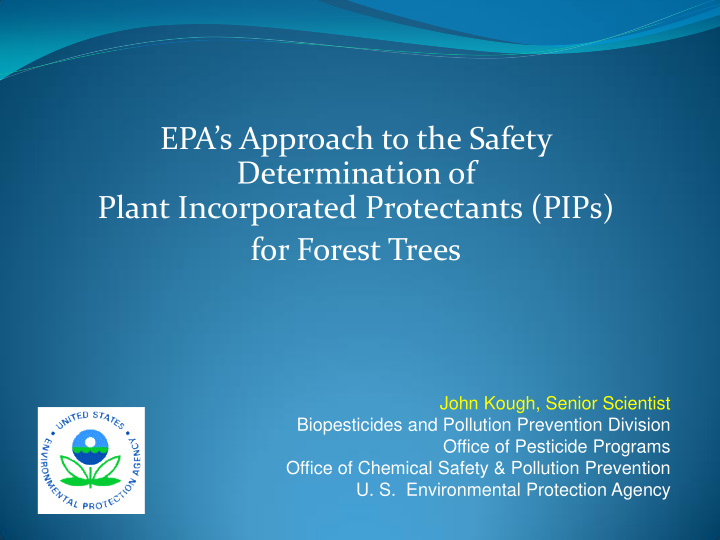



EPA’s Approach to the Safety Determination of Plant Incorporated Protectants (PIPs) for Forest Trees John Kough, Senior Scientist Biopesticides and Pollution Prevention Division Office of Pesticide Programs Office of Chemical Safety & Pollution Prevention U. S. Environmental Protection Agency
Laws & Regulations Federal Insecticide, Fungicide, & Rodenticide Act: Registration of Pesticide Active Ingredients & Products Federal Food Drug & Cosmetic Act: Determination of Safety of Pesticide Residues in Food and Aggregate Exposure 2
Pesticides and PIPs A pesticide is a substance or mixture intended to prevent, destroy, repel or mitigate any pest. 40CFR 152.3 Plant Incorporated Protectant is a pesticidal substance intended to be produced and used in a living plant and the genetic material necessary for its production. 40CFR 174.3 3
SAFETY STANDARDS FIFRA: No unreasonable adverse effects from use of the pesticide on the environment FFDCA: Reasonable certainty of no harm to aggregate exposure of pesticide residues 4
Data Requirements/Endpoints for PIPs Based on Microbial and Biochemical Pesticide Guidelines (40CFR158 subparts U & V) Hazard Consideration for Humans and Non-Target Organisms: Possible Previous Exposure Dietary and Occupational Exposure Environmental Exposure 5
Safety Assessment for PIPs Molecular Characterization Description of introduced genetic material Inheritance and stability of trait Characterization of Expressed Pesticidal Trait Expression levels in tissues 6
Dietary Safety Assessment for PIP Proteins Codex Alimentarius for PIP proteins. Proteins present different issues compared to elaborated chemicals: Predictable Metabolic Fate. Biochemical characteristics: Amino Acid Sequence. Similarity analysis using Toxin and Allergen databases. Toxicity test with pure protein if novel protein. Previous Dietary Exposure. 7
Ecological Effects for PIPs Ecological effects are covered by testing with surrogate species for hazards to aquatic, terrestrial species and honeybees as well as fate studies Tiered approach to testing Maximum hazard dose with no negative effects: High Confidence of No Unreasonable Adverse Effects Adverse effects at Tier I trigger more considerations Previous exposure and expected exposure 8
Summary EPA is looking to reduce the burden of testing while still meeting the intent of the safety standards EPA encourages addressing data requirements with scientific rationale based on peer-reviewed literature where appropriate EPA examines research for new areas that may be relevant for pesticide risk assessment: gene editing and RNAi 9
Recommend
More recommend